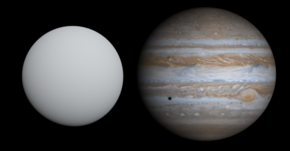
55 Cancri e is an exoplanet in the orbit of its Sun-like host star 55 Cancri A. The mass of the exoplanet is about 8.63 Earth masses and its diameter is about twice that of the Earth, thus making it the first super-Earth discovered around a main sequence star, predating Gliese 876 d by a year. It takes fewer than 18 hours to complete an orbit and is the innermost-known planet in its planetary system. 55 Cancri e was discovered on 30 August 2004. However, until the 2010 observations and recalculations, this planet had been thought to take about 2.8 days to orbit the star. In October 2012, it was announced that 55 Cancri e could be a carbon planet.
HD 147506, also known as HAT-P-2 and formally named Hunor, is a magnitude 8.7 F8 dwarf star that is somewhat larger and hotter than the Sun. The star is approximately 419 light-years from Earth and is positioned near the keystone of Hercules. It is estimated to be 2 to 3 billion years old, towards the end of its main sequence life. There is one known transiting exoplanet, and a second planet not observed to transit.
The Hungarian Automated Telescope Network (HATNet) project is a network of six small fully automated "HAT" telescopes. The scientific goal of the project is to detect and characterize extrasolar planets using the transit method. This network is used also to find and follow bright variable stars. The network is maintained by the Center for Astrophysics | Harvard & Smithsonian.

Epsilon Eridani b, also known as AEgir [sic], is an exoplanet approximately 10.5 light-years away orbiting the star Epsilon Eridani, in the constellation of Eridanus. The planet was discovered in 2000, and as of 2023 remains the only confirmed planet in its planetary system. It orbits at around 3.5 AU with a period of around 7.6 years, and has a mass around 0.6 times that of Jupiter. As of 2023, both the Extrasolar Planets Encyclopaedia and the NASA Exoplanet Archive list the planet as 'confirmed'.

HAT-P-12b, formally named Puli, is an extrasolar planet approximately 468 light years away from Earth, orbiting the 13th magnitude K-type star HAT-P-12, which is located in Canes Venatici constellation. It is a transiting hot Jupiter that was discovered by the HATNet Project on April 29, 2009.

HAT-P-14b, officially named Sissi also known as WASP-27b, is an extrasolar planet located approximately 224.2 ± 0.6 parsecs (731.2 ± 2.0 ly) away in the constellation of Hercules, orbiting the 10th magnitude F-type main-sequence star HAT-P-14. This planet was discovered in 2010 by the HATNet Project using the transit method. It was independently detected by the SuperWASP project.

GJ 3470 b is an exoplanet orbiting the star GJ 3470, located in the constellation Cancer. With a mass of just under 14 Earth-masses and a radius approximately 4.3 times that of Earth's, it is likely something akin to Neptune despite the initially strong belief that the planet was not covered in clouds like the gas giants in the Solar System.
GJ 9827 is a star in the constellation of Pisces. It is a K-type main-sequence star with an apparent magnitude of 10.250. It is 97 light-years away, based on parallax.
HAT-P-26 is a K-type main-sequence star about 466 light-years away. A survey in 2015 did not find any stellar companions in orbit around it, although a red dwarf companion with a temperature 4000+100
−350 K is suspected on wide orbit.
WASP-63 or Kosjenka, also known as CD-38 2551, is a single star with an exoplanetary companion in the southern constellation of Columba. It is too faint to be visible with the naked eye, having an apparent visual magnitude of 11.1. The distance to this system is approximately 942 light-years based on parallax measurements, but it is drifting closer with a radial velocity of −24 km/s.
WASP-69, also named Wouri, is a K-type main-sequence star 164 light-years away. Its surface temperature is 4782±15 K. WASP-69 is slightly enriched in heavy elements compared to the Sun, with a metallicity Fe/H index of 0.10±0.01, and is much younger than the Sun at 2 billion years. The data regarding starspot activity of WASP-69 are inconclusive, but spot coverage of the photosphere may be very high.
HAT-P-38, formally named Horna, is a star located in the northern constellation Triangulum. It has an apparent magnitude of 12.51, making it readily visible in amateur telescopes but not to the naked eye. The object is located relatively far at a distance of 821 light-years based on Gaia DR3 parallax measurements, but it is drifting closer with a spectroscopic radial velocity of −19.85 km/s.










